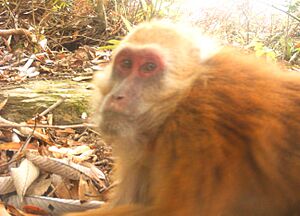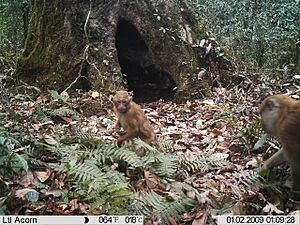Arunachal macaque facts for kids
Quick facts for kids Arunachal macaque |
|
|---|---|
 |
|
| Arunachal macaque from Bugun and Shertukpen forests around Eaglenest WLS | |
| Conservation status | |
| Scientific classification | |
| Genus: |
Macaca
|
| Species: |
munzala
|
 |
|
| Arunachal macaque range | |
The Arunachal macaque (Macaca munzala) is a type of macaque monkey. It lives in the Eastern Himalayas region. You can find it in parts of Bhutan, China, and India. This monkey is currently listed as Endangered. This means it is at high risk of disappearing forever.
Scientists officially described this species in 2005. It is a fairly large brown monkey. It has a tail that is quite short compared to its body. Its name, munzala, comes from the Monpa people. In their language, mun means deep forest and zala means monkey.
Discovering the Arunachal Macaque
The Arunachal macaque was first noticed in 1997. An Indian monkey expert, Anwaruddin Choudhury, saw it. At first, he thought it was a new type of Tibetan macaque.
Then, in 2005, a group of scientists studied it more closely. They were from the Nature Conservation Foundation in India. They realized it was a completely new species of macaque. This was a big deal! It was the first new macaque species found since 1903. That's when the Pagai Island macaque was discovered in Indonesia.
Scientists confirmed this new monkey using a clear photograph. Later, in 2006, the Arunachal macaque was also seen and photographed in Bhutan. This happened in the Trashi Yangshi area.
What the Arunachal Macaque Looks Like
The Arunachal macaque has a strong build. Its face is very dark. These monkeys live in high mountain areas. They are found between 2,000 and 3,500 meters above sea level. This makes them one of the highest-living primates.
This macaque is part of a group of monkeys called the M. sinica species-group. Other monkeys in this group include the Assamese macaque, the Tibetan macaque, the bonnet macaque, and the toque macaque.
The Arunachal macaque looks similar to the Assam and Tibetan macaques. However, its genes show it is more closely related to the bonnet macaque. This is an example of convergent evolution. This means animals can look alike because they live in similar environments. Even if they are not very close relatives, they can develop similar features.
Scientists have counted many Arunachal macaques. Reports from 2006 and 2008 found at least 569 monkeys. They live in 35 different groups. Most of these groups are in Tawang, with a few in West Kameng. Sometimes, these monkeys eat crops from local farms. Because of this, local people sometimes try to scare them away.



